#bryndis petra bragadóttir
Explore tagged Tumblr posts
Photo

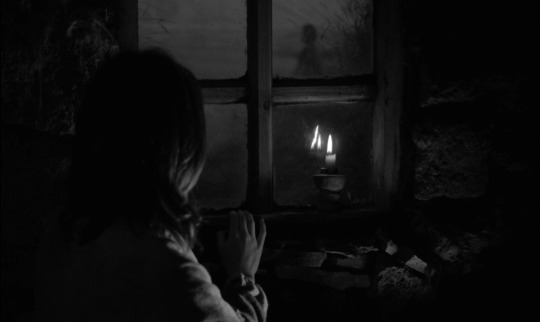
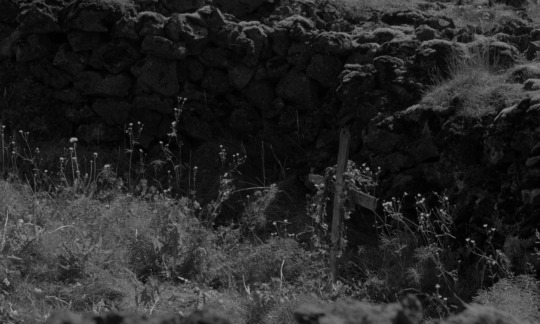


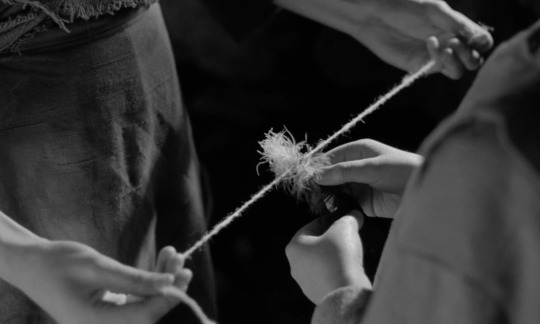

The Juniper Tree (1990) dir. Nietzchka Keene
#the juniper tree#filmedit#nietzchka keene#bjork#bryndis petra bragadóttir#valdimar örn flygenring#cinematography#black and white#films#movies#faceless
432 notes
·
View notes
Text





Nietzchka Keene, {1990} The Juniper Tree
#film#gif#nietzchka keene#the juniper tree#björk#Bryndis Petra Bragadóttir#bryndis petra bragadottir#1990#female filmmakers#black and white#landscapes#people#women#reflections#death#wind#iceland#feature length#poetry#cemeteries#flowers in films#bones#1990s
100 notes
·
View notes
Photo

The Juniper Tree
directed by Nietzchka Keene, 1990
#The Juniper Tree#Nietzchka Keene#movie mosaics#Björk#Geirlaug Sunna Þormar#Valdimar Örn Flygenring#Bryndis Petra Bragadóttir#Guðrún Gísladóttir
23 notes
·
View notes
Text
Review: Björk stars in Nietzchka Keene’s rarely seen film ‘The Juniper Tree’

Björk in the 1989 film “The Juniper Tree.” (Arbelos Films)
BY ROBERT ABELE
APRIL 16, 2019 12:27 PM PT
At the very least, watching Nietzchka Keene’s haunting Icelandic fairy tale “The Juniper Tree” can cause your sense of time to fall away. A black-and-white movie filmed in 1986, it recalls both the indie wilderness vibe of its time, yet also the monochromatic severity of early Bergman and Tarkovsky.
Heading the cast is an instantly recognizable Björk, prior to her becoming a global music phenomenon, which creates its own recontextualized aura around her. It’s also adapted from a Grimm fairy tale, yet infused with a modern feminist sensibility, and while it’s a ghostly affair with magical touches, it’s shot through with a hard-bitten realism about medieval life.
Keene didn’t complete her micro-budgeted debut feature, which she wrote, directed and edited, until 1989, after which it made the festival circuit — including the Sundance Film Festival in 1991 — but only received one Los Angeles showing, in 1990 at UCLA, Keene’s MFA alma mater. Now, 15 years after her death, in her starkly enchanting film has been given a 4K restoration, and another single-viewing chance, this time at the American Cinematheque. The opportunity is a welcome one, because Keene’s atmospheric gem deserves renewed appreciation and fresh discovery.
After finding a dead woman floating in a creek, stoned and drowned as a witch, waif-like Margit (Björk) and her pragmatic older sister Katla (Bryndis Petra Bragadóttir) must flee to avoid the same fate, which also claimed their mother. Stern widowed farmer Johan (Valdimar Örn Flygenring) takes them in, but his suspicious son Jonas (Geirlaug Sunna Þormar) — who visits his mother’s grave every day, like a dutiful son trying not to be forgotten — sees in Katla a family interloper practicing the dark arts.
He’s not entirely wrong, in that Katla believes in sorcery, but she’s also a persecuted woman in a harsh time trying to secure protection for herself and Margit — her seduction spells are born out of a desire to bind Johan to her, which she comes to realize would best be achieved with a pregnancy.
Jonas tries to turn his father against Katla, even though he isn’t so fearful of kindly, concerned Margit, and the young pair bond over their respective grief. But when Margit begins seeing visions of her dead mother — a silent, beckoning figure with a black hole in her chest — Jonas’ dislocation intensifies, until he feels the need to confront his stepmother at the most unwise of moments.
Those familiar with the original fairy tale will know where this is headed. Keene’s retelling preserves certain morbid details but alters others, so that a story steeped in misogyny and the supernatural can still resonate as a warning of the damaging ripple effects when desperation, displacement and mourning collide.
Stylistically, the movie is a stroll of otherworldly delirium, like a hybrid of Dreyer’s asceticism and the the chillier reveries in “The Night of the Hunter.” There’s austere beauty in cinematographer Randy Sellars’ rendering of the craggy, unforgiving Icelandic landscape, and for the memorable hypnagogic passages that occasionally fold over Margit’s reality, Keene enlisted acclaimed avant-garde director and optical effects guru Pat O’Neill.
Folk tales are how cultures make sense of the world, of how people changed and fates were secured. Keene fully grasps this, which is why she often has Björk’s Margit turning the details of the story she’s observing around her — hovering birds, a tended grave, her own loss, a boy’s worry, a woman’s desire — into a fanciful yarn she’s constantly spinning and revising. And Björk’s turn is a delicate, inviting thing, that innocent croak of a voice like some bridge between the mystical appeal of fairy tales and the cold truth about what human beings do when reason leaves them.
Keene made only a couple of films in her abbreviated life, but “The Juniper Tree” is absorbing enough to make one rue there weren’t more. But we can at least note for the history books that for all the hype Lars von Trier received for casting Björk in 2000’s “Dancer in the Dark,” a female filmmaker recognized her eccentric on-screen blend of mystery, humanity and guilelessness first.
#Björk#Björk Guðmundsdóttir#The Juniper Tree#Bryndis Petra Bragadóttir#Guðrún Gísladóttir#Valdimar Örn Flygenring#Geirlaug Sunna Þormar#Patrick Moyroud#Nietzchka Keene#Iceland#Quando Éramos Bruxas#Quand nouEinitréð#s étions sorcières#ビョークの「ネズの木」 グリム童話より#Krzew jałowca#Можжевеловое дерево#Cuando fuimos brujas#Ardıç Ağacı#Seljalandsfoss Waterfall#Larry Lipkis#Los Angeles Times#LA Times
1 note
·
View note
Photo
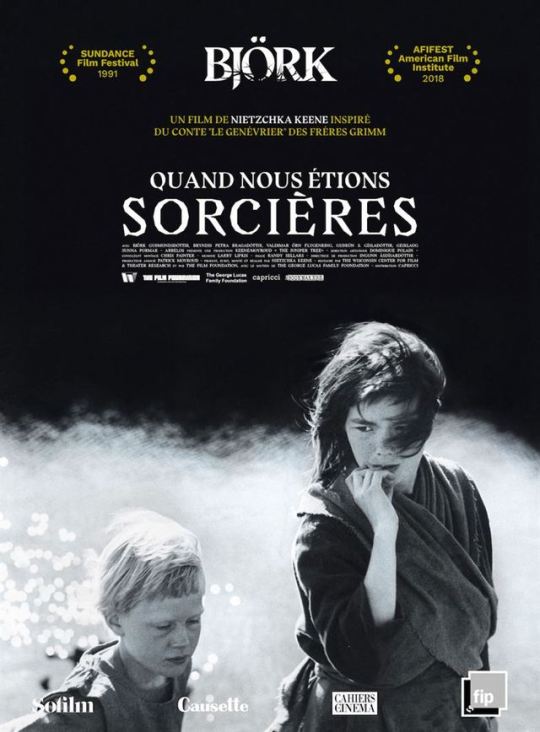
"Quand Nous Etions Sorcières" de Nietzchka Keene (1989) - inspiré du conte le "Genévrier" des frères Grimm (1812) - avec Björk, Bryndis Petra Bragadóttir, Valdimar Örn Flygenring et le petit Geirlaug Sunna Þormar, mai 2019.
1 note
·
View note
Photo



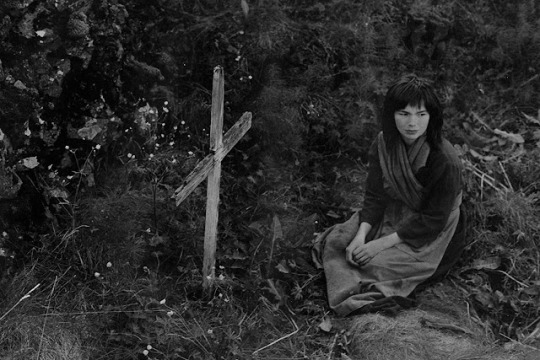
The Juniper Tree (Nietzchka Keene, 1990) Cast: Björk, Bryndis Petra Bragadóttir, Valdimar Örn Flygenring, Guðrún Gisladóttir, Geirlaug Sunna Þormar. Screenplay: Nietzchka Keene. Cinematography: Randolph Sellars. Art direction: Dominque Polain. Film editing: Nietzchka Keene. Music: Larry Lipkis. Nietzchka Keene's The Juniper Tree, the first feature in her sadly brief career, reminded me of films by Bergman and Dreyer, largely because of its bleakly beautiful, isolated, apparently medieval setting. It has also been called "feminist," a label often pasted on films directed by women, though I think it transcends labels and influences, working its effect largely through the strength of some well-imagined characters. The sisters Margit and Katla have been left homeless after their mother was burned as a witch, so Katla, the elder, casts a spell on Jóhann, a handsome young widower, and the sisters go to live with him. Jóhann's young son, Jónas, resents his stepmother and lovingly tends his mother's grave, a devotion that only feeds his animosity toward Katla, though he makes friends with Margit, who has visions of her own late mother. Eventually, as in all such tales, tensions, fed by Katla's witchcraft, Margit's visions, and Jónas's resentment, result in calamity. It's a simple story with roots in a tale from the Brothers Grimm, given potency by good performances, particularly Björk as the pivotal character of Margit, by a strong eroticism in the relationship of Katla and Jóhann, and by the exploration of the Icelandic setting in Randolph Sellars's handsome black-and-white cinematography.
0 notes
Text
The Juniper Tree - Nietzchka Keene (1990)

"The Juniper Tree is a 1990 Icelandic black-and-white medieval fantasy drama film directed and written by Nietzchka Keene. Based on the fairy tale 'The Juniper Tree' collected by the Brothers Grimm, it stars a small cast of five actors: Björk, Bryndis Petra Bragadóttir, Guðrún Gísladóttir, Valdimar Örn Flygenring and Geirlaug Sunna Þormar. The Juniper Tree is set in Iceland and portrays the story of two sisters, Margit (Björk Guðmundsdóttir) and her elder sister Katla (Bryndis Petra Bragadóttir), who escape their home after their mother (Guðrún Gísladóttir) is stoned and burned for witchcraft. They go where no one knows them, and find Jóhann (Valdimar Örn Flygenring), a young widower who has a son called Jónas (Geirlaug Sunna Þormar). Katla uses magical powers to seduce Jóhann and they start living together. Margit and Jónas become friends. However, Jónas does not accept Katla as his stepmother and tries to convince his father to leave her. ..."
Wikipedia
W - The Juniper Tree (fairy tale)
W - Nietzchka Keene
NY Times - ‘The Juniper Tree’ Review: A Young Björk Enchants in Her Film Acting Debut (Video)
The Juniper Tree - Jacob and Wilhelm Grimm
YouTube: The Juniper Tree | Trailer, Interview with Nietzchka Keene the writer-director of "The Juniper Tree"

0 notes
Text
New Trailer for Restored Re-Release of 'The Juniper Tree' with Björk
"Out from here, away be gone." Arbelos Films has debuted a new trailer for the restored re-release of The Juniper Tree, a surrealist film from 1990 filmed in Iceland and made by filmmaker Nietzchka Keene. The film stars a young Björk (25 years old at the time) as a woman who flees her homeland in Iceland after her mother is killed for practicing witchcraft. Her older sister casts a spell on a farmer which makes him fall in love with her, but his son sees through her tricky plan. The full cast includes Bryndis Petra Bragadóttir, Valdimar Örn Flygenring, Guðrún Gísladóttir, and Geirlaug Sunna Þormar. This 4K restoration is from the Wisconsin Center for Film & Theater Research and The Film Foundation, with funding from the George Lucas Family Foundation. The Juniper Tree is described as a "potent allegory for misogyny and its attendant tragedies, [and] a major rediscovery for art house audiences." It seems very dreamlike and poetic. ›››
Continue Reading New Trailer for Restored Re-Release of 'The Juniper Tree' with Björk
from FirstShowing.net https://ift.tt/2SUUIFl
0 notes
Photo



The Juniper Tree | Nietzchka Keene | 1990
Bryndis Petra Bragadóttir, Geirlaug Sunna Þormar, Valdimar Örn Flygenring, Björk
#Bryndis Petra Bragadóttir#Geirlaug Sunna Þormar#Valdimar Örn Flygenring#Björk#Nietzchka Keene#The Juniper Tree#1990
21 notes
·
View notes
Text
The Juniper Tree
Every woman ought to know that fairy tales are not to be trusted-especially not those (re)written by The Brothers Grimm. Thankfully, Nietzchka Keene's The Juniper Tree returns this tale to its rightful place: as told from a woman's perspective, as too often, they are not. Anyone who has read Clarissa Pinkola Estés' groundbreaking "Women Who Run with The Wolves" will welcome this feminist interpretation of what (in the Grimms' hands) is actually an incredibly misogynist, violent, cautionary tale against brave little girls who dare disobey. And anyone who hasn't yet, should-especially the many critics attempting to analyze and canonize Keene's film in relation to the works of her more familiar male peers (e.g. Bergman, Tarkovsky, or Vláčil) whose films bear only aesthetic resemblance to what is otherwise a truly original modern gothic masterpiece. It seems appropriate that this film should re-emerge now, after so many years of being unappreciated or misunderstood, lost in the shadows of the zeitgeist. The Juniper Tree, like the rapturous and recently re-released work of Hilma af Klint, was -alas- ahead its time.
I'll admit, as with likely most viewers, it was the prospect of seeing Björk in her on-screen debut that caught my attention. Björk plays Margit, a young woman, who, along with her older sister, Katla (Bryndis Petra Bragadóttir) is forced to flee into the wilderness after their mother was accused of witchcraft and killed. Katla encounters a single man living alone in the wild. They fall in love, and the sisters are invited to move in- with him and his young son, the product of a prior marriage. The boy immediately resents Katla, fearing that his new stepmother will replace his own, now long dead and buried under The Juniper Tree. However, he grows to trust and befriend Margit, who meanwhile struggles to control and interpret her own ecstatic visions- for fear that she, like her mother, may be accused of witchcraft. The boy's resentment festers and escalates. He spurns Kata's attempts to connect with and care for him. His father likewise falls prey to doubt and paranoia, now caught between conflicting feelings of loyalty to his son, desire for love, and guilt for his desire. Everybody feels threatened -everyone except Margit, the only one able to see through all the reactionary behavior to the truth of the matter. This guilelessness, however, gets her into trouble. And therein lies the true moral of the story, ladies: Beware your own ability to think and see clearly, when those around you cannot.
Beyond the pleasures of watching a young, "undiscovered' Björk perform, the film has so much more to offer in the way of story, cinematography, and-my god--the sound! The sensual and evocative images, actions, and landscapes are more than enough to keep you hooked, all the way to the end. Come for the Björk, yes, but stay for the Keene. I'm embarrassed not to have known her till now. Ill cast as wide a spell as I can: Nietzchka Keene. Nietzchka Keene. Nietzchka Keene Originally published March 9th 2019 in Screen Slate.
Angeline Gragasin is a NYC-based writer, filmmaker, and artist who tells stories about ecology, memory, and power. You can learn more about her and her work at www.angelinegragasin.com.
Personal Reminiscences of The Juniper Tree by Patrick Moyroud
I met Nietzchka Keene at the UCLA film school, when we were both graduate students. She and I both had an interest in the use of sound to enhance and support the visual elements in film. We worked together mixing soundtracks for each other's film projects, and recording novel and authentic sound effects. It seemed to us that soundtracks were often left until the last stage in production, and suffered from a lack of complexity and originality. We spent hours recording just the right sound of a body falling to the ground, or some barely perceptible ambience in a forest far from the city.
Nietzchka's early films contained many elements of the mood, structure and composition seen in The Juniper Tree: barren, bleak landscapes, mysterious characters with conflicted motivations, and ambiguous endings. One could also say that they took place in a different universe, where time and location were less important than mood and ambience, which worked together to dissociate the viewer from any hint of reality.
Prior to film school, Nietzchka's major at UCLA was folklore, an important element throughout all her work, and which added to the timeless nature of the stories. Her last two features, Heroine of Hell and Barefoot to Jerusalem, continued the same themes. Juniper was shot in Iceland during the summer of 1986, at a time when the country was barely on the tourist circuit, let alone a major filming location. The script is based on a Grimm Brothers story of the same name. Nietzchka spent a year in Iceland beforehand, exploring locations, studying the folklore and history, and selecting the cast and crew.
From the very beginning, the project was an adventure. The Juniper Tree could easily qualify as a low-budget film, although today it might be called micro-budget. Nonetheless, Nietzchka and her cinematographer Randy Sellars managed to create hauntingly beautiful imagery. The location challenges were many. We brought the Arriflex camera from the US, and most of the lighting equipment from France. There was only one generator truck in the whole country - an antique van that provided just barely enough power. The maritime climate was unpredictable, and the wildlife - mostly sea birds - objected strongly to our presence by bombarding us as we shot scenes near their nests.
In spite of all the difficulties, or perhaps because of them, we persevered and eventually completed the filming in about 4 weeks. I believe that the camaraderie, passion, and determination of our small cast and crew contributed much to Juniper's successful completion. Sadly, Nietzchka left us in October 2004, with several finished and unfinished scripts waiting to be produced. While we may never see what other great films she had in her mind, at least we can be happy in knowing that this one will continue to honor her memory. I hope you enjoy it.
"I made what was in my heart, essentially" — Nietzchka Keene
Patrick Moyroud was the associate producer of The Juniper Tree.
A Visionary Rediscovered by Amy Sloper
The reintroduction of The Juniper Tree follows a familiar path, playing in many of the same cities and venues that it screened in during the film's initial release 1989. The first time around, the film was commonly seen at women's film festivals, with filmmaker Nietzchka Keene on hand for introductions and question and answer sessions. Now the film is on a restoration circuit, often with a member of the restoration team or an original crew member on hand to introduce audiences to what they are about to see. The individual attention given to the film at each stage, by the filmmakers, the programmers, the audiences, and the restoration team, seems wholly appropriate for a film whose meditative and mystical quality was out of keeping with the mainstream industry's expectations both then and now. It is sadly not surprising that for a period the film and filmmaker were all but forgotten, along with many of the other independent films of women during this time period, while its artistic accomplishments have become only more apparent with the passage of time.
Filmmaker Nietzchka Keene was born and raised near Boston, Massachusetts, receiving her BA at U-Mass, Amherst, and her MFA from UCLA. In 1985 she was awarded a Fulbright Fellowship to Iceland where she wrote and prepared for production of The Juniper Tree, returning to shoot the film in 1987. It was the first film to star the well-known singer and actor Björk (billed at the time as Björk Gumundsdóttir), in the role of a young child in a story based on a fairy tale from the Brothers Grimm. Keene won a Verna Fields Memorial Scholarship from UCLA in 1987 to edit The Juniper Tree, completing it in 1989. In 1995, after a long tour with the film, which screened at over 23 festivals worldwide, Keene began her tenure as a professor at the University of Wisconsin-Madison teaching filmmaking, where she remained until her death at the age of 52 due to cancer.
Keene's entire archive was donated to the Wisconsin Center for Film & Theater Research, a significant film archive on the UW-Madison campus, with the intention of making it available for future scholarship. This is where the only print of The Juniper Tree was known to exist prior to this restoration project, alongside the picture negatives and original sound elements for this and all of filmmaker Nietzchka Keene's other work, which include three short films she made while a film student at UCLA - Friends (1977), Still (1978), and Hinterland (1981) - a 1996 television movie, Heroine of Hell, starring Catherine Keener and Dermot Mulroney, an animated short in 1998 called Aves, and her unfinished feature Barefoot to Jerusalem, which was shot in Madison, WI and the Upper Peninsula of Michigan.
I was an undergraduate studying film at UW-Madison in the late 1990s, and Nietzchka was my advanced production professor. She made a strong impression, particularly with regard to the need for an unforgiving nature in the pursuit of a vision. As her longtime friend and the producer of The Juniper Tree Patrick Moyroud put it:
"She had her own ideas and goals for what she wanted to accomplish and would follow them with intensity and strength. Sometimes that meant stepping on toes ... not many people have produced, written and directed three feature films on budgets that would not even pay for a three-bedroom house today?
Nietzchka was instrumental on my path from Madison, writing my letter of recommendation to UCLA's newly established program in Moving Image Archive Studies in 2003. From there I followed a path very similar to hers, first to positions working with film and video collections in Los Angeles, then to Massachusetts working at the Harvard Film Archive. In 2014, I returned to Madison to head the film and video collections of the Wisconsin Center for Film & Theater Research, where I was very humbled to be managing Nietzchkas collection alongside the materials of Shirley Clarke, Jill Godmilow, the United Artists studio, and Emile de Antonio, among others. I was also startled to hear that the single print of The Juniper Tree - at that time the only print we knew existed - had been loaned out to venues as far away as Australia. Visions of the print getting lost in transit or accidentally being damaged by a venue rattled my brain. At the same time, I was thrilled to know that there was sustained interest in the film, and knew that we needed to find a way to make new film prints and digital screening copies available so we were not taking unnecessary risk with the single existing print.
A restoration project for a feature film can cost into the six figures, and with no internal budget for preservation work at the Center for Film & Theater Research, I teamed up with restorationist Ross Lipman, well-known for his restoration work on American independent and experimental cinema as well as his own work as a filmmaker, and also a mentor and collaborator since my days at UCLA. We approached The Film Foundation, the non-profit founded in 1990 by Martin Scorsese to support the preservation and restoration of cinema. At the time, The Film Foundation was interested in establishing relationships with smaller film archives, lucky for us, so we worked to establish a relationship for The Juniper Tree project. Another stroke of luck, The Film Foundation was also expanding their funding specifically to work on the restoration of work by female filmmakers. The final stroke of luck was working with Kris Merola at The Film Foundation, who gently guided us through the grant writing process. Ross and I worked on the grant in tandem, with Ross to manage all of the lab work on the ground in Los Angeles. The restoration proposal was funded in 2017 from The Film Foundation and The George Lucas Family Foundation. The restoration and re-release of The Juniper Tree is a triumph that required dedication from so many partners, from Nietzchka and Patrick Moyroud who took such good care of the film materials all along, to the archivists of the Wisconsin Center for Film & Theater Research from 2004 onwards who performed the rehousing and cataloging work to make the collection discoverable (and continue facilitating research access to this day), to The Film Foundation and The George Lucas Family Foundation for generously funding the restoration, and finally to Ross Lipman and all of the staff at the labs he worked with on the analog and digital restoration.
The belated recognition Nietzchka Keene is receiving for her previously under- known masterpiece is made all the more significant by The Juniper Tree's powerful evocation of the cultural isolation of visionary women. It is shocking how a film so recent and so powerful can be forgotten so quickly - an error we hope to rectify with this new restoration.
Amy Sloper is the Collections Archivist at the Harvard Film Archive.

About the Restoration
Arbelos release of The Juniper Tree has been fully preserved in 35mm and remastered to 4K digital Video by the Wisconsin Center for Film and Theater Research and The Film Foundation, with funding provided by The George Lucas Family Foundation.
Photochemical picture source was the original 35mm BW picture negative A & B rolls. These were used by Fotokem as the source for a fully timed 35mm answer print, release print, and preservation fine grain master positive.
In parallel to the photochemical work, the original 35mm BW picture negative A & B rolls were scanned in 4K on a Lasergraphics ScanStation, and digitally reconstituted, cleaned up, and graded at Muminate Hollywood. The 35mm films natural grain has been left untouched. The black-and-white grading was approved by cinematographer Randy Sellars.
Sound source was the original 35mm magnetic soundtrack mix, which was captured and remastered at Audio Mechanics, Burbank.
All preservation elements, film and digital, are in permanent storage in Wisconsin.
Restoration Supervisor: Ross Lipman In consultation with: Amy Sloper, Patrick Moyroud, Randy Sellars DI Colorist: Andrew Drapkin, Illuminate Hollywood Film Scanning and Digital mastering: Illuminate Hollywood 35mm film printing: Fotokem 35mm grader: Doug Ledin, Fotokem Audio Restoration and Mastering: John Polito, Audio Mechanics. Special Thanks: Steve Wiener, Bill Tayman, Kim Young, Andrew Oran, Simon Daniel Production Credits Producer: Ei Toshinari Blu-ray Mastering: David Mackenzie, Fidelity in Motion Package Design: Dylan Haley Subtitles: CMI Media Management Co-CEO, Distribution: David Marriott Co-CEO, Post-Production: Craig Rogers Chief Strategy Officer: Dennis Bartok EVP of Strategy: Joseph Kaufman Chief Business Development Officer: Jonathan Marlow Special Thanks: Patrick Moyroud, Randy Sellars, Ross Lipman, Amy Sloper, Wisconsin Center for Film and Theater Research (WCFTR), Kristen Merola, The Film Foundation, Mary K. Huelsbeck, Boyd Hillestad, Jeff Feller, Jon Manning, Angeline Gragasin, Jon Dieringer, Screen Slate, Michael Lieberman.
Acknowledgements: Arbelos has thoroughly sought to contact all relevant rights holders and copyright owners. Should any party find that their rights were inadvertently retained, we would welcome correspondence from them.
On YouTube: https://youtu.be/POwG00JWrRo
1 note
·
View note
Photo









The Juniper Tree | Nietzchka Keene | 1990
21 notes
·
View notes